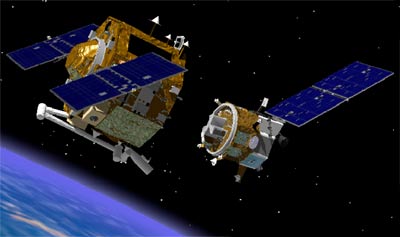Thank you very much for visiting Gunter's Space Page. I hope that this site is useful and informative for you.
If you appreciate the information provided on this site, please consider supporting my work by making a simple and secure donation via PayPal. Please help to run the website and keep everything free of charge. Thank you very much.
ASTRO

ASTRO (left) docks with NEXTSat/CSC (right) [Boeing]
The ability to refuel, reconfigure and repair satellites has been considered a top priority by both the military and civilian space-launch and satellite industry for many years. A major step toward that goal was initiated in March 2002, when Boeing was selected by the Defense Advanced Research Projects Agency (DARPA) as the prime integrator to perform Phase II of the Orbital Express Advanced Technology Demonstration. Under a 42-month $113 million agreement with options, a Boeing Phantom Works team finalized the design, completed fabrication and demonstrated the various technologies required for autonomous satellite servicing while on-orbit.
The unique Orbital Express advanced technology demonstrator has the capability to safely and autonomously service and refuel satellites while onorbit. The Boeing team built the ASTRO (Autonomous Space Transport Robotic Operations satellite), and a surrogate next generation serviceable satellite, NEXTSat/CSC, and conducted an on orbit demonstration of autonomous satellite servicing. Launch took place in 2007, with routine, cost-effective, autonomous capability for re-supply and reconfiguration of on-orbit spacecraft planned for the post-2010 timeframe.
DARPA envisions an operational Orbital Express derived satellite servicing architecture as ushering in a new revolution in space operations. In this capacity, future systems will employ cost-effective autonomous maneuverable satellites capable of resupply and reconfiguration on-orbit. This system would support critical national security missions, as well as civil and commercial space activities.
In addition, NASA's on-going Space Launch Initiative (SLI) program is partnering with DARPA in the Orbital Express demonstration to reduce technical risks associated with developing autonomous rendezvous capabilities. Leveraging work done through the Orbital Express technology demonstration is one step toward enabling potential commercial logistics missions to the International Space Station.
The Boeing Phantom Works Orbital Express Team includes Ball Aerospace and Technologies Corp., TRW Space and Technology, McDonald Dettwiler Robotics, Draper Laboratory Inc., and Starsys Research Corp.
| Nation: | USA |
|---|---|
| Type / Application: | Remote Servicing Technology |
| Operator: | DARPA |
| Contractors: | Boeing |
| Equipment: | |
| Configuration: | |
| Propulsion: | |
| Power: | 2 deployable solar arrays, batteries |
| Lifetime: | |
| Mass: | 700 kg |
| Orbit: | 450 km × 450 km, 38° |
| Satellite | COSPAR | Date | LS | Launch Vehicle | Remarks | |
|---|---|---|---|---|---|---|
| ASTRO | 2007-006A | 09.03.2007 | CC SLC-41 | Atlas-5(401) | with NEXTSat/CSC, STPSat 1, CFESat, MidSTAR 1, FalconSat 3 |
References:
- Boeing: Orbital Express
